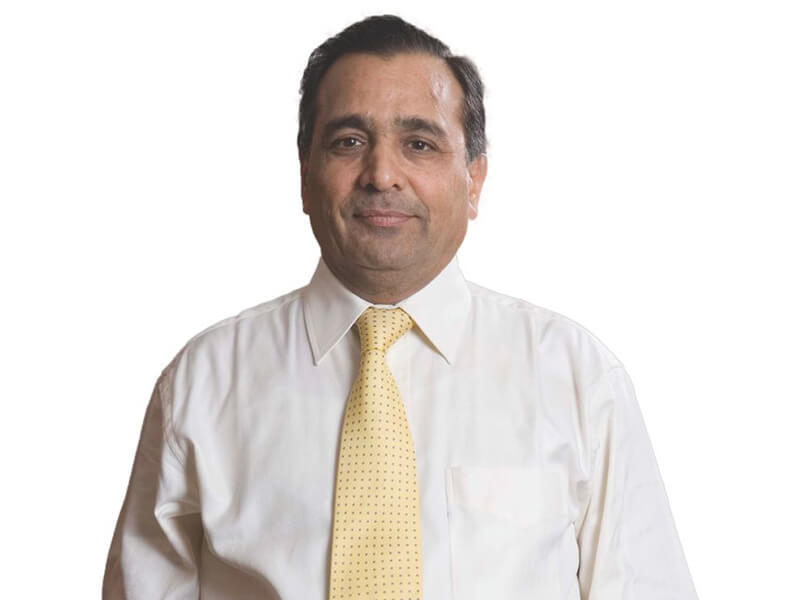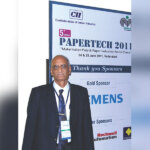
Mr. K.L. Chandak has gone through ranks at West Coast Paper Mills Ltd. and now manages the mill as the Executive Director. He has also served as a Director of Rama Newsprint & Papers Ltd, Bahubali Papers Ltd., Speciality Coating and Lamination Ltd. Above all he is a chartered accountant and a coveted rank-holder in ICAI . He is committed and indebted to Bangur family who has provided him growth opportunity from management trainee to executive director over the career span of 40 years in the company. With his inherent quality of meticulous planning, quick and precise decision-making traits, he has played a vital role in the execution of 1425 crores expansion project which has provided WCPM a leap of ambition.
.
.
Paper Mart: What are the factors that have helped the propagation of the idea for such a huge expansion of Rs. 1400 crores e.g. growth prospects, competition etc. Explain briefly?
K.L. Chandak: Expansion programme completed at an investment of about Rs. 1425 crores which ensured the long term viability of the unit by increase in production from 180,000 TPA to 320,000 TPA (including 135,000 TPA on new paper machine – No. VI) and cutting costs due to scale of operations. It was also for better environment compliance as fiber line with elementary chlorine free (ECF) technology has been installed not only for incremental production but also for taking care of pre-expansion production capacity. It has also helped us in improving the quality of the paper in terms of brightness and strength properties, particularly copier paper production on new paper machine No. VI is very well accepted in the market in terms of quality. We are also able to tap industrial consumers as we can deliver excellent reel quality on the new paper machine and even reeling quality from the existing machines has improved. Our export target on PM VI is 25% of production. Concurrently, we have also strengthened our product mix derived from the new machine; we produce writing and printing paper of a higher bulk with the same grammage. Varied grammage were also introduced in copier paper with corresponding brands.
The project has been mostly funded through foreign currency loan / external commercial borrowings to the extent of USD 165 million (about Rs.750 crores) at lower rate of interest which is presently less than 2.5% p.a. International Finance Corporation, Washington has participated to the extent of USD 40 million, whereas USD 105 million was funded by ICICI bank led syndicate and remaining USD 20 million by Barclays bank.
PM: What factors were taken into consideration before finalizing the expansion in various areas of the mill? Kindly elaborate the Technology & Equipments selected for respective areas?
KLC: Thrust was to adopt latest technology in all sections i.e., pulp mill, chemical recovery and power house. The equipments have been purchased from reputed national and international suppliers so that we get the benefit of cost reduction apart from quality improvement. The company has also gone for backward integration in terms of plantations in a major way so as to ensure that at least 50% of the requirement of raw material (wood) is met from captive plantations. It has already raised plantations in 21,916 acres till 2010 rains and target is to plant 100,000 acres over a period of time.
Technology & Equipments selected for respective areas:
• Pulping – ECF. Supplier Metso Paper
• 135,000 TPA Paper M/c – Voith Paper
• Power Generation, Utilities, etc.
…• 34.5 MW Turbine – Bharat Heavy Electricals Ltd
…• 125 TPH AFBC Boiler -Thermax, Babcox & Wilcox
PM: What were the challenges faced during the execution of entire project and how you overcome that?
KLC: We had faced problem of project over-run due to delay in commissioning on account of government actions, including employment visa restriction on foreign technicians engaged in project work. Further, it is a brown field project and hence equipments were to be installed within the available space in the existing factory premises. Teething problems were also faced with various equipments which have been successfully resolved and now the plant is fully operational.
PM: How are you meeting increased raw material requirements to service your expanded capacity?
KLC: We require around 900,000 tons of raw-material per annum to feed our enlarged paper production capacity, completely procured from the current market. However, a few years ago, we embarked on contracts for farming scheme, wherein we identified fallow/waste land belonging to marginal farmers within a 250 km radius from our manufacturing unit. We provided clonal seedlings to these farmers, encouraging them to raise plantations from a long-term perspective with the safety net of an assured buyback. This proposition will lead to a win-win situation, provide income for wasteland owners and enhance our raw material security. We expect to derive raw materials from 661 acres (planted in 2006) of our total plantations in 21,916 acres currently. We expect to scale up with speed; our annual plan is to plant 10,000 acres, and based on an average yield of 40 to 60 tons per acre, we expect to secure 50% of our annual raw material requirements from these proximate plantations over the foreseeable future. This will not only protect our raw material sourcing from a volume perspective but it will also provide us with robust raw material, leading to superior paper quality.
PM: How do you view the fundamentals of the Indian paper market, given the volatility in demand, supply and prices and what are the drivers and enablers of growth for the industry?
KLC: The country’s paper industry is in good health; the copier and packaging paper segments are growing at an annual rate of 15%, even as the other segments are growing at 5-7% per year. The government’s thrust on the education sector is likely to catalyze paper demand from a per capita consumption figure of 9.6 kg – considerably lower than the international average. Further, we feel that an increase in disposable incomes and faster rural economic growth will strengthen paper demand – even a one kg per capita consumption increase could enhance annual paper demand by about 1.2 million TPA. We hope that paper market will remain buoyant, given the demand drivers, particularly industrialization and government focus on education. There is replacement demand also, particularly cup stock board replacing plastic and paper replacing plastic packing for Ghutka, etc. Due to recession from 2008, effective actions for creation of additional capacity have not been taken in the last 3 years and therefore paper realization should improve on account of demand/supply mismatch.
In addition to India our existing markets of focus are the Middle East, Africa and South East Asia. Our technology up-gradation helped us present superior grades in line with the requirements in these geographies.
PM: Lastly the recent acquisition of APPM by International paper in India shows that most of the times the Indian paper industry has been undervalued. After this acquisition BILT Paper Plc has kept on hold its IPO in UK for re-rating of the industry. Does this acquisition has really paved way for the Indian paper industry to get image makeover and rather appropriate valuation and might also open up a trend of consolidation in the Indian paper industry. Comments?
KLC: We do agree that acquisition of APPM by International Paper will definitely add value to the paper sector as more international players will be interested in this industry, given the growth scenario in Indian paper market. It will also make paper industry more competitive.
WCPM entered the paper industry in 1955 with a production capacity of 18,000 TPA, which gradually increased to 1,80,000 TPA in a little more than 50 years; then within the space of just three years we increased our capacity by 78% to 3,20,000 TPA, indicating the management’s faith in the long-term viability of this business.



